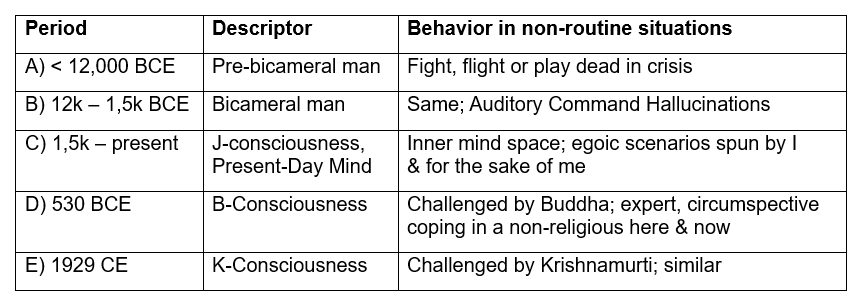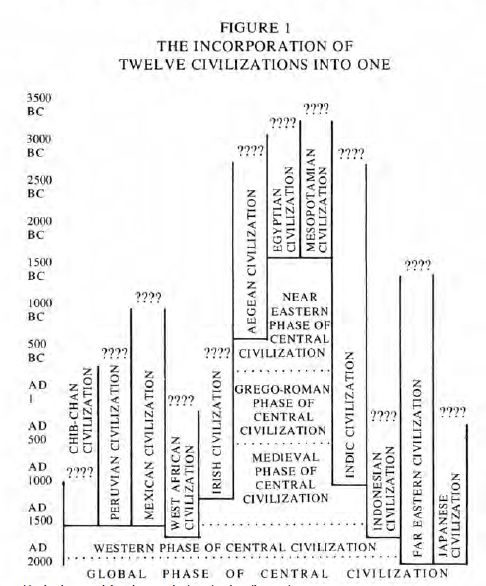And What Has That to Do With the Restoration of the Ecosystem?
Introduction
In order to have a good grasp of what is possible in the future we need a good grasp on what has happened so far in the past. And if the aim is the assessment of the possibility that earth’s ecosystem can be restored, we need an assessment of the causes which lead to the dire ecological situation humanity finds itself in.
The following short paper is an admittedly speculative contribution to this assessment and is rooted in a particular philosophical history of consciousness. The guiding idea of this presentation is that consciousness has contingent structures and dynamics. Because it is contingent and left a historical record, it has a history which can be explicated and narrated.
The psychological hypotheses of Julian Jaynes and the teachings of global philosopher Jiddu Krishnamurti are central in the construction of this narrative. A short introduction of both will clarify why.
Julian Jaynes
Julian Jaynes (1920-1997) was an American psychologist who consternated quite some academics and lay people with his controversial 1976 book The Origin of Consciousness in the Breakdown of the Bicameral Mind.
In this intriguing study Jaynes developed four hypotheses which more or less hang together but can also be addressed separately. I will give a very short formulation of the first two.
1) J-Consciousness. This technical term refers to our modern sense of individuality and interiority and can be named “Introspectable inner mind space”, in which an analogue “I” can move around a metaphoric “me” in different scenarios to figure out and evaluate possible actions in order to cope with unfamiliar situations. Jaynes takes great pains to make clear that ‘consciousness’ is not to be equated with perception or sentience. It is made up of language in the format of narrativity and is an analogue to the real world. (65ff, 204ff & 447-52)
2) The Bicameral Mind. In ancient times individuals and groups, when in stressful, non-routine situations, were directed by Auditory Command Hallucinations (ACH) to successfully navigate the dangerous unknown. These commands originate in the right brain hemisphere and are received in the left hemisphere. Except for recent instances, recipients experience such commands as coming from outside themselves as if coming from a different, more authoritative being. Jaynes thinks this ‘mental architecture’ might have started around 12,000 BCE and was dominant till 1,000 BCE, after which J-consciousness set in (84ff & 452-3).
In short, one could say that J-consciousness is a manner of coping with the world through the metaphorical constitution of an introspectable inner mind space which is a selective and storied analog of the real world in which an analog ‘I’ can move around a metaphor ‘Me’ in a spatialized temporality in which the analog ‘I’ can switch swiftly between memories and expectations all in order to figure out possible actions congruent with its narrative arc.
Krishnamurti
Krishnamurti and his teachings are hard to classify, but naming him a global philosopher spreading a transformative philosophy might come close, especially if philosophy is not taken in the western, modern professional-technical meaning, but as the public pursuit of wisdom done through a variety of discourses. Though born in India and carrying throughout his life an Indian passport, I do not consider him an Indian philosopher.
His central concern is conveyed in the phrase ‘choiceless awareness’. The idea of ‘choiceless awareness’ is to convey the possibility to observe also without any reactivity, without any sense of judgement. It is what it is, as people say, and only when a person, idea, problem is approached in non-reactive awareness will there be a chance to see ‘what is’. And if ‘what is’ is some egoic or ego-centric process, merely observing it without judging, might lead to its transformation and overcoming.
As far as the role of thought is concerned Krishnamurti was very respectful of science and rationality, but also sharply critical of some of its inventions like god(s), soul, religions, ideologies, and the most dangerous invention of all, the ‘me’, the ego, the sense of separate selfness. Most, if not all, human problems start there and can only be solved there.
In short, one could say that Krishnamurti sees human liberation only in and through a close, non-judgmental awareness and intuitive understanding of the mind’s processes. When, in this process of self-knowledge, or awareness of the self, the observer realizes he is the observed, total transformation can take place.
Note that Jaynes’ notion of the introspectable inner mind space is almost congruent with Krishnamurti’s concept of the ‘me’ or ‘self’. Their specific differences and similarities I have worked out in a forthcoming paper.
History of Consciousness
With the above minimal groundwork a history of consciousness and its contingent structures can be worked out. The first column has the approximate dates; the second its best one-word description; the third has some crucial aspects as far as its architecture / mentality is concerned and how it deals with uncommon, non-routine situations and crises.
B-consciousness is my name given to the first serious challenge to, or improvement of, J-consciousness. And K-consciousness is the second serious one. This doesn’t exclude that there were many in between.
The shift from the bicameral mind to J-consciousness is still in full swing and has the following dynamics:
A) Attempts to re-activate the bicameral mind by religious practices like ecstasies, divination, inspirations, mediumship and more recent channeling. Where bicameral man had the certainty of being pushed around by commands and had no second thoughts about its wisdom and correctness, J-consciousness has to live with an awareness of the contingency of its actions based on the plurality of possibilities. One way out of this uncertainty is to reactivate the bicameral mind through certain spiritual techniques and be guided again by voices or by divined signs. There exist innumerable practices of this kind, which all have in common that a basic question of ‘what should I do’ will be answered as if coming from on high while it is the subconscious which is producing the voices and / or interpretations.
B) The move to overcome religious impulses in more rational and naturalized frameworks amplified by the Greek philosophical revolution of 700 – 300 BCE and similar developments in Asia. The other route to attain certainty about action is by improving the capacity to rationally analyze alternate courses of action. Logic, rationality, experimentation and imagination are all practices which will improve the predictability of action and take away a certain amount of anxiety.
C) The Rise of Central Civilization incorporating all other civilizations in one global entity driven by an egocentric impulse based in J-consciousness (See Appendix A). If you look at the figure in Appendix A you will see an alternative conceptualization of the march of civilizations. This one is based on the merging of, on one side, historical investigations of comparing civilizations (Toynbee, 1947a, b, 1962-64; Quigley, 1979), and on the other side, sociological investigations in the field of world-system theory (Wallerstein, 1974-1989; Frank, 1998). What both seem to agree on is that the origin of now globalized western civilization is merely a phase of what they call ‘central civilization’, i.e. the merger of Egyptian and Mesopotamian civilizations around 1,500 BCE, which then went through a Near-Eastern phase, then a Greco-Roman phase, then a Medieval one, then Western and now a Global phase. In its growth it gobbled up almost any and all other civilizations (Wilkinson, 1997).
Central Civilization emerged around 1,500 BCE out of an intense civilizational conflict in which Jaynes argues the bicameral mind found its demise and J-consciousness its start as a better coping mechanism (Jaynes, 1976: 223f). Bicamerally ruled empires around the Mediterranean might have found their end during a “perfect storm of calamities” early in the 12th century BCE of earthquakes, rebellion, invasions, collapse of trade, disease, drought and famine (Cline, 2021: 134f). Since then this ‘mental architecture’ went through many modes of interiorization and is now also global.
The questions, or hypotheses, are 1) whether it was specifically J-consciousness, in its more powerful mode of planning and rationality, which gave central civilization its staying power and dubious success over others; 2) if Buddhist civilization(s) can be construed as a possible first attempts to overcome J-consciousness with a new mentality, which I will name B-consciousness, but failed; and 3) if K-consciousness–also based on a different architecture, but not dissimilar to Buddhism–as allegedly lived and promoted by Krishnamurti, might become another challenge to the reigning J-consciousness.
Transition to a Sustainable Civilization
The connection of the history of consciousness and its future along the lines of what Krishnamurti proposes should be connected to the idea of ecosystem restoration. It is possible that only under the aegis of a civilization inspired by the ecological sensitivities and ideas of Krishnamurti that humanity will be able to construct a sustainable civilization. This might take 200-500 years. Only then the very much needed restoration of the ecosystem can be executed with any success of making the relationship between humanity and nature truly sustainable. How bad the ecological and social situation might have turned is anybody’s guess, but a short dark age of anarchy and chaos is not out of the question. But, so far, humanity has gone through many of them before and survived to tell the story.
Origin
“The Future of Consciousness: Is Krishnamurti Its Prophet? And What Has That to Do With the Restoration of the Ecosystem?” is a short paper presented at the Indian Philosophical Congress (IPC), 95th session, Gandhi University, Wardha, Maharashtra, on December 29, 2022. The title is borrowed from my former philosophy teacher Theodore Kisiel, who gave a lecture at the Theosophical Society in America (Wheaton, Illinois) about Martin Heidegger titled “The Future of Being: Is Heidegger Its Prophet?”
Sources
Agrawal, M. M. 1991a. Consciousness and the Integrated Being: Sartre and Krishnamurti. Shimla, India: Indian Institute of Advanced Studies.
Agrawal, M. M. 1991b. “Nothingness and Freedom: Sartre and Krishnamurti”. Journal of Indian Council of Philosophical Research, 9/1: 45-58.
Cline, Eric H. 2021. 1177 BC: The Year Civilization Collapsed. Revised and updated. Princeton: Princeton University Press.
Dreyfus, Hubert. 1972. What Computers Can’t Do: The Limits of Artificial Intelligence. New York: Free Press.
—— . 2002. “A phenomenology of skill acquisition as the basis for a Merleau-Pontian nonrepresentational cognitive science.” (2002)
—— & Stuart Dreyfus. 1980. “A Five-Stage Model of the Mental Activities Involved in Directed Skill Acquisition“. Washington, DC: Storming Media.
—— & —— . 1986. Mind Over Machine: The Power of Human Intuition and Expertise in the Era of the Computer. New York: Free Press.
—— & ——- . 1991. “Towards a Phenomenology of Ethical Expertise.” Human Studies, 14/4: 229-250.
Frank, Andre Gunder. 1998. ReOrient: Global Economy in the Asian Age. Berkeley: University of California Press.
Jaynes, Julian. 1982 (1976). The Origin of Consciousness in the Breakdown of the Bicameral Mind. 2nd edition with added Afterword. New York: Houghton Mifflin Harcourt.
Julian Jaynes Society. www.julianjaynes.org
Krishnamurti, J. 1929. “The Dissolution of the Order of the Star: A Statement”. International Star Bulletin (September 1929): 28-34. Also titled “Truth is a Pathless Land“.
—– . 1954. The First and Last Freedom. Foreword by Aldous Huxley. New York: Harper & Brothers.
—– . 1976. Krishnamurti’s Notebook. New York: Harper & Row.
Lutyens, Mary. 1975. Krishnamurti: The Years of Awakening, Avon Books, New York.
Martin, Raymond & Barresi, John. 2006. The Rise and Fall of Soul and Self: An Intellectual History of Personal Identity. New York: Columbia U.P.
Quigley, Carroll. 1979. The Evolution of Civilizations: An Introduction to Historical Analysis. Liberty Fund.
Rodrigues, Hillary. 1990. Insight and Religious Mind: An Analysis of Krishnamurti’s Thought. American University Studies, Series VII, Theology and Religion, Vol. 64. Master of Arts Thesis, McMaster University, 1988. New York: Peter Lang.
Rorty, Amelie O. 1976. “A Literary Postscript: Characters, Persons, Selves, Individuals”. In: Rorty, Amelie O. (Ed.), The Identities of Persons. Berkeley, CA: University of California Press. 301-323. Also in: Rorty, Amelie O. (Ed.). 1988. Mind in Action. Boston: Beacon Press, 1988.
Sartre, Jean-Paul. 1957 (1936). The Transcendence of the Ego. Trans. Williams, F. & Kirkpatrick, R (Transl.). New York: The Noonday Press.
Schuller, Govert. 1997. Krishnamurti and the World Teacher Project: Some Theosophical Perceptions. Theosophical History Journal, Occasional Paper V.
—— . 2014. “The Jaynesian Paradigm and Beyond“. Alpheus, January 2014.
Taylor, Charles. 1989. Sources of the Self: The Making of the Modern Identity. Cambridge, UK: Cambridge UP.
Toynbee, Arnold J. 1962–1964 [1934–1961]. A Study of History. 12 vols. Oxford: Oxford University Press.
Wallerstein, Immanuel. 1974-1989. The Modern World-System. 3 volumes. New York & San Diego & London: Academic Press.
Wilkinson, David. 1987. “Central Civilization”. Comparative Civilizations Review, 17/17: Article 4. Also in: Sanderson, Stephen K., 1995, Civilizations and World Systems: Studying World-historical Change, Lanham, MD: Rowman Altamira, pp. 46-74.
“AMI Conference Statement to COP26: Regarding the Monetary Dimension of Climate Change”. American Monetary Institute, Evanston, IL, USA, 11 Nov 2021.
Appendix A.
Central Civilization (Figure 2.1 from Wilkinson, 1997: 32).

